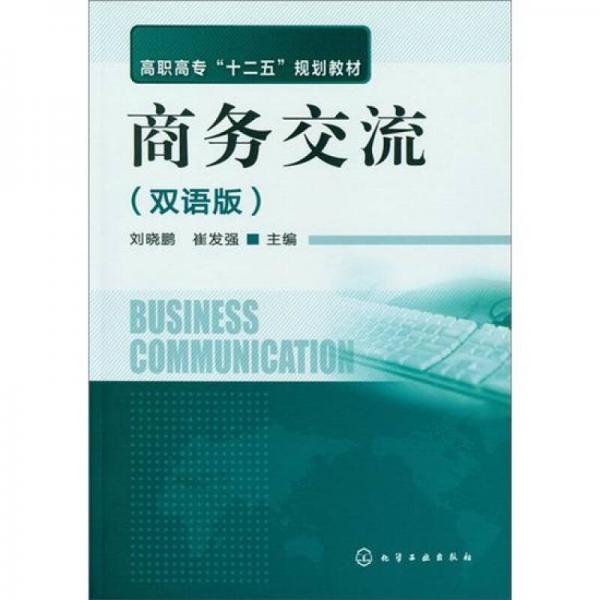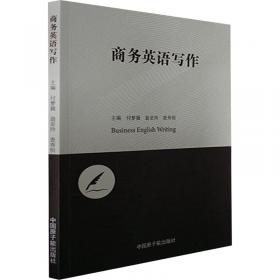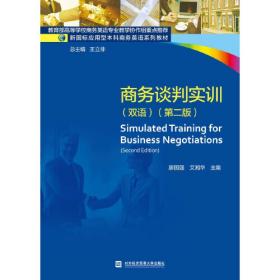商务交流(双语版)
出版时间:
2012-09
版次:
1
ISBN:
9787122146359
定价:
24.00
装帧:
平装
开本:
16开
纸张:
胶版纸
页数:
143页
正文语种:
简体中文,英语
-
《商务交流(双语版)》以商务和管理活动为背景,按由简到繁、先基础后提高的思路编排,内容包括:有效信函的基础、各种信息的传达、求职,以及大型会议的演讲、报告等。最后设习题,便于读者练习和自我检测。
本书适用于高职高专经贸类专业以及其他相关专业的师生使用,也可以作为涉外企业从业人员的自学资料。 1.Communication s Foundation
1.1The importance communication
1.2The managerial functions of communication
1.3Formats for letters,memos,and email messages
1.3.1Formats for letters
1.3.2Formats for Memos
1.3.3Formats for eMail Messages
2.The Structure of Your document
2.1Choosing words
2.2Developing sentences
2.3Developing paragraphs
2.3.1What is a paragraph·
2.3.2The Basic Rule:Keep One Idea to One Paragraph
2.3.3Elements of a Paragraph
3.How to Start/Answer/End Letters
3.1How to Start Your Letter
3.1.1Thank You letter
3.1.2A Letter of Request
3.1.3Introduction letter
3.2How to Answer Letter
3.2.1Complaint Letter
3.2.2Decline Letter
3.3How to End Letter
4.Good News
4.1How to Write a Subject Line
4.1.1Making Subject Lines Specific
4.1.2Making Subject Lines Concise
4.1.3Making Subject Lines Appropriate for the Pattern of Organization
4.2The Organization of Good News
4.3When to use reader benefits
4.4The most common kinds of informative and positive messages
4.4.1ThankYou and Congratulatory Notes
4.4.2Adjustments and Responses to Complaints
4.4.3Transmittals
4.4.4Confirmations
5.Bad News
5.1The Parts of a Bad News
5.1.1Subject Lines
5.1.2Buffers
5.1.3Reasons
5.1.4Refusals
5.1.5Alternatives
5.1.6Endings
5.2How to organize Negative Messages
5.2.1Negative messages to clients and customers
5.2.2Negative messages to superiors
5.2.3Negative messages to peers and subordinates
5.3Example
6.How to Apologize & How to Make a Mild Complaint
6.1How to Apologize
6.2How to Make a Mild Complaining Letter
6.2.1Background
6.2.2Problem
6.2.3Solution
6.2.4Warning (optional)
6.2.5Closing
6.3Example
7.Persuasive Messages
7.1The importance of persuasive messages
7.2The classification and features of persuasive messages
7.3Choosing a Persuasive Strategy
7.3.1What do you want people to do·
7.3.2What objections, if any, will the audience have·
7.3.3How strong a case can you make·
7.3.4What kind of persuasion is best for the organization, and the culture·
7.4Using Your Analysis to Choose a Persuasive Strategy
7.4.1Writing Persuasive Direct Request
7.4.2Writing Persuasive ProblemSolving Messages
7.5Tone in Persuasive Messages
7.6Varieties of Persuasive Messages
7.6.1Collection Letters
7.6.2Performance Appraisals
7.6.3Letters of Recommendation
7.7Solving a Sample Problem
8.Identify Purposes of Writing and Building Goodwill
8.1To build goodwill
8.2To create youattitude
8.3Positive emphasis
8.4Reducing bias
9.Reports
9.1Title page
9.2Letter or memo of transmittal
9.3Table of contents
9.4List of illustrations
9.5Executive summary
9.6Introduction
9.7Background or History
9.8Conclusions and Recommendations
10.Graphs and Other Visuals
10.1When to use visuals
10.2Designing visuals
10.3Integrating visuals in your text
11.Citing and Referencing
11.1Intext citation
11.2Bibliography/References
12.Resume
12.1When to prepare your job hunting
12.2Evaluating your strengths and interests
12.3What to include in a resume
12.4Guidelines for resume
12.5Mistakes and errors in a resume
12.6Dealing with difficulties
13.Making Oral Presentations
13.1Dealing with fear
13.2Purposes in oral presentations
13.3Planning a strategy for your presentation
13.4Your opening and close should be strong
13.4.1Your opener
13.4.2Your End
13.5Planning PowerPoint Slides
13.6Organizing your information
13.7Delivering a presentation
13.8An example presentation text
14.Organizing a meeting
14.1First decide if you need to have a meeting
14.2How to organize a meeting
14.2.1Identify the need for a meeting
14.2.2Planning a meeting
14.2.3Arranging a meeting
14.2.4Preparing for a meeting
14.2.5Running a meeting
14.2.6Finalizing & issuing the agreed minutes
14.3During a meeting
14.3.1At the beginning, you d have Small Talk
14.3.2Welcome
14.3.3Introductions
14.3.4Roll Call/Apologies
14.3.5Objectives
14.3.6Following the Agenda
14.3.7Closing a Meeting
14.4Vocabulary for meetings
Exercises
-
内容简介:
《商务交流(双语版)》以商务和管理活动为背景,按由简到繁、先基础后提高的思路编排,内容包括:有效信函的基础、各种信息的传达、求职,以及大型会议的演讲、报告等。最后设习题,便于读者练习和自我检测。
本书适用于高职高专经贸类专业以及其他相关专业的师生使用,也可以作为涉外企业从业人员的自学资料。
-
目录:
1.Communication s Foundation
1.1The importance communication
1.2The managerial functions of communication
1.3Formats for letters,memos,and email messages
1.3.1Formats for letters
1.3.2Formats for Memos
1.3.3Formats for eMail Messages
2.The Structure of Your document
2.1Choosing words
2.2Developing sentences
2.3Developing paragraphs
2.3.1What is a paragraph·
2.3.2The Basic Rule:Keep One Idea to One Paragraph
2.3.3Elements of a Paragraph
3.How to Start/Answer/End Letters
3.1How to Start Your Letter
3.1.1Thank You letter
3.1.2A Letter of Request
3.1.3Introduction letter
3.2How to Answer Letter
3.2.1Complaint Letter
3.2.2Decline Letter
3.3How to End Letter
4.Good News
4.1How to Write a Subject Line
4.1.1Making Subject Lines Specific
4.1.2Making Subject Lines Concise
4.1.3Making Subject Lines Appropriate for the Pattern of Organization
4.2The Organization of Good News
4.3When to use reader benefits
4.4The most common kinds of informative and positive messages
4.4.1ThankYou and Congratulatory Notes
4.4.2Adjustments and Responses to Complaints
4.4.3Transmittals
4.4.4Confirmations
5.Bad News
5.1The Parts of a Bad News
5.1.1Subject Lines
5.1.2Buffers
5.1.3Reasons
5.1.4Refusals
5.1.5Alternatives
5.1.6Endings
5.2How to organize Negative Messages
5.2.1Negative messages to clients and customers
5.2.2Negative messages to superiors
5.2.3Negative messages to peers and subordinates
5.3Example
6.How to Apologize & How to Make a Mild Complaint
6.1How to Apologize
6.2How to Make a Mild Complaining Letter
6.2.1Background
6.2.2Problem
6.2.3Solution
6.2.4Warning (optional)
6.2.5Closing
6.3Example
7.Persuasive Messages
7.1The importance of persuasive messages
7.2The classification and features of persuasive messages
7.3Choosing a Persuasive Strategy
7.3.1What do you want people to do·
7.3.2What objections, if any, will the audience have·
7.3.3How strong a case can you make·
7.3.4What kind of persuasion is best for the organization, and the culture·
7.4Using Your Analysis to Choose a Persuasive Strategy
7.4.1Writing Persuasive Direct Request
7.4.2Writing Persuasive ProblemSolving Messages
7.5Tone in Persuasive Messages
7.6Varieties of Persuasive Messages
7.6.1Collection Letters
7.6.2Performance Appraisals
7.6.3Letters of Recommendation
7.7Solving a Sample Problem
8.Identify Purposes of Writing and Building Goodwill
8.1To build goodwill
8.2To create youattitude
8.3Positive emphasis
8.4Reducing bias
9.Reports
9.1Title page
9.2Letter or memo of transmittal
9.3Table of contents
9.4List of illustrations
9.5Executive summary
9.6Introduction
9.7Background or History
9.8Conclusions and Recommendations
10.Graphs and Other Visuals
10.1When to use visuals
10.2Designing visuals
10.3Integrating visuals in your text
11.Citing and Referencing
11.1Intext citation
11.2Bibliography/References
12.Resume
12.1When to prepare your job hunting
12.2Evaluating your strengths and interests
12.3What to include in a resume
12.4Guidelines for resume
12.5Mistakes and errors in a resume
12.6Dealing with difficulties
13.Making Oral Presentations
13.1Dealing with fear
13.2Purposes in oral presentations
13.3Planning a strategy for your presentation
13.4Your opening and close should be strong
13.4.1Your opener
13.4.2Your End
13.5Planning PowerPoint Slides
13.6Organizing your information
13.7Delivering a presentation
13.8An example presentation text
14.Organizing a meeting
14.1First decide if you need to have a meeting
14.2How to organize a meeting
14.2.1Identify the need for a meeting
14.2.2Planning a meeting
14.2.3Arranging a meeting
14.2.4Preparing for a meeting
14.2.5Running a meeting
14.2.6Finalizing & issuing the agreed minutes
14.3During a meeting
14.3.1At the beginning, you d have Small Talk
14.3.2Welcome
14.3.3Introductions
14.3.4Roll Call/Apologies
14.3.5Objectives
14.3.6Following the Agenda
14.3.7Closing a Meeting
14.4Vocabulary for meetings
Exercises
查看详情
-
2012-09 印刷
印次: 1
九品
北京市顺义区
平均发货5小时
成功完成率97.46%
-
2012-09 印刷
印次: 1
九品
北京市顺义区
平均发货5小时
成功完成率97.46%

 占位居中
占位居中

















